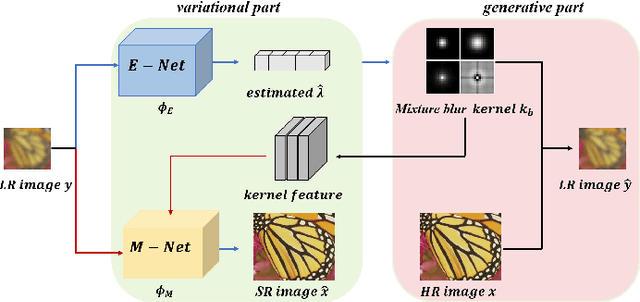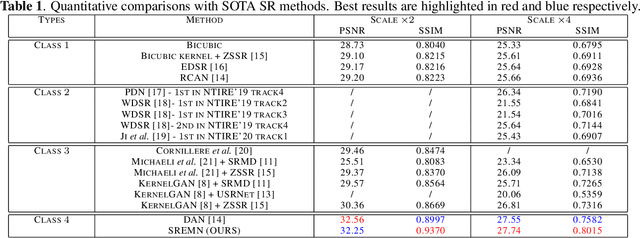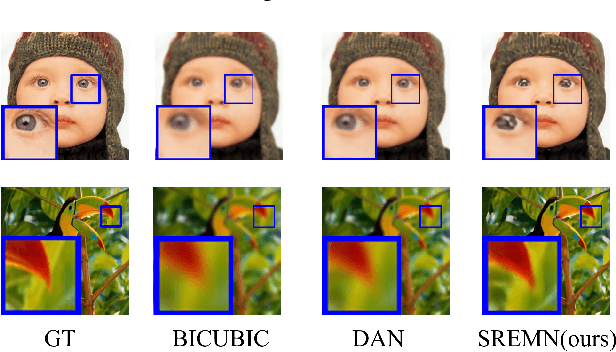Yuxiao Li
Image-to-Image Translation with Diffusion Transformers and CLIP-Based Image Conditioning
May 21, 2025Abstract:Image-to-image translation aims to learn a mapping between a source and a target domain, enabling tasks such as style transfer, appearance transformation, and domain adaptation. In this work, we explore a diffusion-based framework for image-to-image translation by adapting Diffusion Transformers (DiT), which combine the denoising capabilities of diffusion models with the global modeling power of transformers. To guide the translation process, we condition the model on image embeddings extracted from a pre-trained CLIP encoder, allowing for fine-grained and structurally consistent translations without relying on text or class labels. We incorporate both a CLIP similarity loss to enforce semantic consistency and an LPIPS perceptual loss to enhance visual fidelity during training. We validate our approach on two benchmark datasets: face2comics, which translates real human faces to comic-style illustrations, and edges2shoes, which translates edge maps to realistic shoe images. Experimental results demonstrate that DiT, combined with CLIP-based conditioning and perceptual similarity objectives, achieves high-quality, semantically faithful translations, offering a promising alternative to GAN-based models for paired image-to-image translation tasks.
CT-PatchTST: Channel-Time Patch Time-Series Transformer for Long-Term Renewable Energy Forecasting
Jan 15, 2025Abstract:Accurately predicting renewable energy output is crucial for the efficient integration of solar and wind power into modern energy systems. This study develops and evaluates an advanced deep learning model, Channel-Time Patch Time-Series Transformer (CT-PatchTST), to forecast the power output of photovoltaic and wind energy systems using annual offshore wind power, onshore wind power, and solar power generation data from Denmark. While the original Patch Time-Series Transformer(PatchTST) model employs a channel-independent (CI) approach, it tends to overlook inter-channel relationships during training, potentially leading to a loss of critical information. To address this limitation and further leverage the benefits of increased data granularity brought by CI, we propose CT-PatchTST. This enhanced model improves the processing of inter-channel information while maintaining the advantages of the channel-independent approach. The predictive performance of CT-PatchTST is rigorously analyzed, demonstrating its ability to provide precise and reliable energy forecasts. This work contributes to improving the predictability of renewable energy systems, supporting their broader adoption and integration into energy grids.
Generalization from Starvation: Hints of Universality in LLM Knowledge Graph Learning
Oct 10, 2024



Abstract:Motivated by interpretability and reliability, we investigate how neural networks represent knowledge during graph learning, We find hints of universality, where equivalent representations are learned across a range of model sizes (from $10^2$ to $10^9$ parameters) and contexts (MLP toy models, LLM in-context learning and LLM training). We show that these attractor representations optimize generalization to unseen examples by exploiting properties of knowledge graph relations (e.g. symmetry and meta-transitivity). We find experimental support for such universality by showing that LLMs and simpler neural networks can be stitched, i.e., by stitching the first part of one model to the last part of another, mediated only by an affine or almost affine transformation. We hypothesize that this dynamic toward simplicity and generalization is driven by "intelligence from starvation": where overfitting is minimized by pressure to minimize the use of resources that are either scarce or competed for against other tasks.
CellAgent: An LLM-driven Multi-Agent Framework for Automated Single-cell Data Analysis
Jul 13, 2024Abstract:Single-cell RNA sequencing (scRNA-seq) data analysis is crucial for biological research, as it enables the precise characterization of cellular heterogeneity. However, manual manipulation of various tools to achieve desired outcomes can be labor-intensive for researchers. To address this, we introduce CellAgent (http://cell.agent4science.cn/), an LLM-driven multi-agent framework, specifically designed for the automatic processing and execution of scRNA-seq data analysis tasks, providing high-quality results with no human intervention. Firstly, to adapt general LLMs to the biological field, CellAgent constructs LLM-driven biological expert roles - planner, executor, and evaluator - each with specific responsibilities. Then, CellAgent introduces a hierarchical decision-making mechanism to coordinate these biological experts, effectively driving the planning and step-by-step execution of complex data analysis tasks. Furthermore, we propose a self-iterative optimization mechanism, enabling CellAgent to autonomously evaluate and optimize solutions, thereby guaranteeing output quality. We evaluate CellAgent on a comprehensive benchmark dataset encompassing dozens of tissues and hundreds of distinct cell types. Evaluation results consistently show that CellAgent effectively identifies the most suitable tools and hyperparameters for single-cell analysis tasks, achieving optimal performance. This automated framework dramatically reduces the workload for science data analyses, bringing us into the "Agent for Science" era.
LLM-Powered Explanations: Unraveling Recommendations Through Subgraph Reasoning
Jun 22, 2024



Abstract:Recommender systems are pivotal in enhancing user experiences across various web applications by analyzing the complicated relationships between users and items. Knowledge graphs(KGs) have been widely used to enhance the performance of recommender systems. However, KGs are known to be noisy and incomplete, which are hard to provide reliable explanations for recommendation results. An explainable recommender system is crucial for the product development and subsequent decision-making. To address these challenges, we introduce a novel recommender that synergies Large Language Models (LLMs) and KGs to enhance the recommendation and provide interpretable results. Specifically, we first harness the power of LLMs to augment KG reconstruction. LLMs comprehend and decompose user reviews into new triples that are added into KG. In this way, we can enrich KGs with explainable paths that express user preferences. To enhance the recommendation on augmented KGs, we introduce a novel subgraph reasoning module that effectively measures the importance of nodes and discovers reasoning for recommendation. Finally, these reasoning paths are fed into the LLMs to generate interpretable explanations of the recommendation results. Our approach significantly enhances both the effectiveness and interpretability of recommender systems, especially in cross-selling scenarios where traditional methods falter. The effectiveness of our approach has been rigorously tested on four open real-world datasets, with our methods demonstrating a superior performance over contemporary state-of-the-art techniques by an average improvement of 12%. The application of our model in a multinational engineering and technology company cross-selling recommendation system further underscores its practical utility and potential to redefine recommendation practices through improved accuracy and user trust.
Generalized Expectation Maximization Framework for Blind Image Super Resolution
May 23, 2023



Abstract:Learning-based methods for blind single image super resolution (SISR) conduct the restoration by a learned mapping between high-resolution (HR) images and their low-resolution (LR) counterparts degraded with arbitrary blur kernels. However, these methods mostly require an independent step to estimate the blur kernel, leading to error accumulation between steps. We propose an end-to-end learning framework for the blind SISR problem, which enables image restoration within a unified Bayesian framework with either full- or semi-supervision. The proposed method, namely SREMN, integrates learning techniques into the generalized expectation-maximization (GEM) algorithm and infers HR images from the maximum likelihood estimation (MLE). Extensive experiments show the superiority of the proposed method with comparison to existing work and novelty in semi-supervised learning.
Variational Bayesian Framework for Advanced Image Generation with Domain-Related Variables
May 23, 2023


Abstract:Deep generative models (DGMs) and their conditional counterparts provide a powerful ability for general-purpose generative modeling of data distributions. However, it remains challenging for existing methods to address advanced conditional generative problems without annotations, which can enable multiple applications like image-to-image translation and image editing. We present a unified Bayesian framework for such problems, which introduces an inference stage on latent variables within the learning process. In particular, we propose a variational Bayesian image translation network (VBITN) that enables multiple image translation and editing tasks. Comprehensive experiments show the effectiveness of our method on unsupervised image-to-image translation, and demonstrate the novel advanced capabilities for semantic editing and mixed domain translation.
* 5 pages, 2 figures,
A Deep Learning Approach for Generating Soft Range Information from RF Data
May 23, 2023



Abstract:Radio frequency (RF)-based techniques are widely adopted for indoor localization despite the challenges in extracting sufficient information from measurements. Soft range information (SRI) offers a promising alternative for highly accurate localization that gives all probable range values rather than a single estimate of distance. We propose a deep learning approach to generate accurate SRI from RF measurements. In particular, the proposed approach is implemented by a network with two neural modules and conducts the generation directly from raw data. Extensive experiments on a case study with two public datasets are conducted to quantify the efficiency in different indoor localization tasks. The results show that the proposed approach can generate highly accurate SRI, and significantly outperforms conventional techniques in both non-line-of-sight (NLOS) detection and ranging error mitigation.
* Published in: 2021 IEEE Globecom Workshops (GC Wkshps)
Deep GEM-Based Network for Weakly Supervised UWB Ranging Error Mitigation
May 23, 2023Abstract:Ultra-wideband (UWB)-based techniques, while becoming mainstream approaches for high-accurate positioning, tend to be challenged by ranging bias in harsh environments. The emerging learning-based methods for error mitigation have shown great performance improvement via exploiting high semantic features from raw data. However, these methods rely heavily on fully labeled data, leading to a high cost for data acquisition. We present a learning framework based on weak supervision for UWB ranging error mitigation. Specifically, we propose a deep learning method based on the generalized expectation-maximization (GEM) algorithm for robust UWB ranging error mitigation under weak supervision. Such method integrate probabilistic modeling into the deep learning scheme, and adopt weakly supervised labels as prior information. Extensive experiments in various supervision scenarios illustrate the superiority of the proposed method.
* 6 pages, 4 figures, Published in: MILCOM 2021 - 2021 IEEE Military Communications Conference (MILCOM)
Benchmarking Interpretability Tools for Deep Neural Networks
Feb 08, 2023Abstract:Interpreting deep neural networks is the topic of much current research in AI. However, few interpretability techniques have shown to be competitive tools in practical applications. Inspired by how benchmarks tend to guide progress in AI, we make three contributions. First, we propose trojan rediscovery as a benchmarking task to evaluate how useful interpretability tools are for generating engineering-relevant insights. Second, we design two such approaches for benchmarking: one for feature attribution methods and one for feature synthesis methods. Third, we apply our benchmarks to evaluate 16 feature attribution/saliency methods and 9 feature synthesis methods. This approach finds large differences in the capabilities of these existing tools and shows significant room for improvement. Finally, we propose several directions for future work. Resources are available at https://github.com/thestephencasper/benchmarking_interpretability
 Add to Chrome
Add to Chrome Add to Firefox
Add to Firefox Add to Edge
Add to Edge